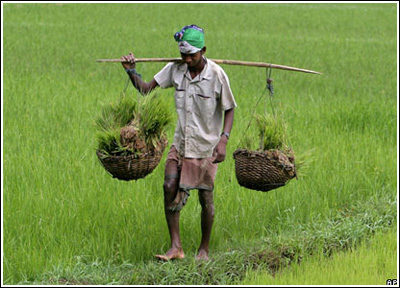Article and Image courtesy: Infochange India
Author: Rahul Goswami
Celebrating the fact that per capita agricultural income is increasing faster than overall per capita income, the government is targeting 4% growth in agriculture in the Twelfth Plan period. But this is a rosy view that does not stand up to scrutiny.

The food grains view from mid-2011 is one of relative comfort -- 235 million tonnes is the estimate (including 94 mt rice and 84 mt wheat).
From this position, the Government of India has a set of six broad-brush objectives. These it wants its ministries and departments, connected directly and as adjunct to food and its provision, to internalise. It wants state governments to shape policy to support these objectives, which are:
- Target at least 4% growth for agriculture. Cereals are on target for 1.5% to 2% growth. India should concentrate more on other foods and on animal husbandry and fisheries where feasible
- Land and water are the critical constraints. Technology must focus on land productivity and water use efficiency
- Farmers need better functioning markets for both outputs and inputs. Also, better rural infrastructure, including storage and food processing
- States must act to modify the Agricultural Produce Marketing Committee (APMC) Act/Rules (exclude horticulture), modernise land records and enable properly recorded land lease markets
- The Rashtriya Krishi Vikas Yojana (RKVY) has helped convergence and innovation and gives state governments flexibility. This must be expanded in the Twelfth Plan
- The Mahatma Gandhi National Rural Employment Guarantee Scheme (MGNREGS) should be redesigned to increase contribution to land productivity and rain-fed agriculture. Similarly, the Forest Rights Act (FRA) has potential to improve forest economies and tribal societies. But convergence with the National Rural Livelihoods Mission (NRLM) is required for strengthening rural livelihoods
Are these objectives reasonable? Are they equitable and will they encourage an agriculture that is ecologically sustainable in India? From a resources use perspective, the government is right to point out certain constraints (land and water) and administrative improvements (land records, using NREGA labour for farm needs). The direction to provide better infrastructure in India's rural districts, the better to link farmers to markets with, has been stated in every single Five Year Plan for the last five plan periods, and has been repeated in every single plan review and even more often in the Economic Surveys which accompany the annual budgets. (Under the Bharat Nirman programme, this need has to an extent been met, but the beneficiaries are as likely industry and land developers as they are cultivators.)